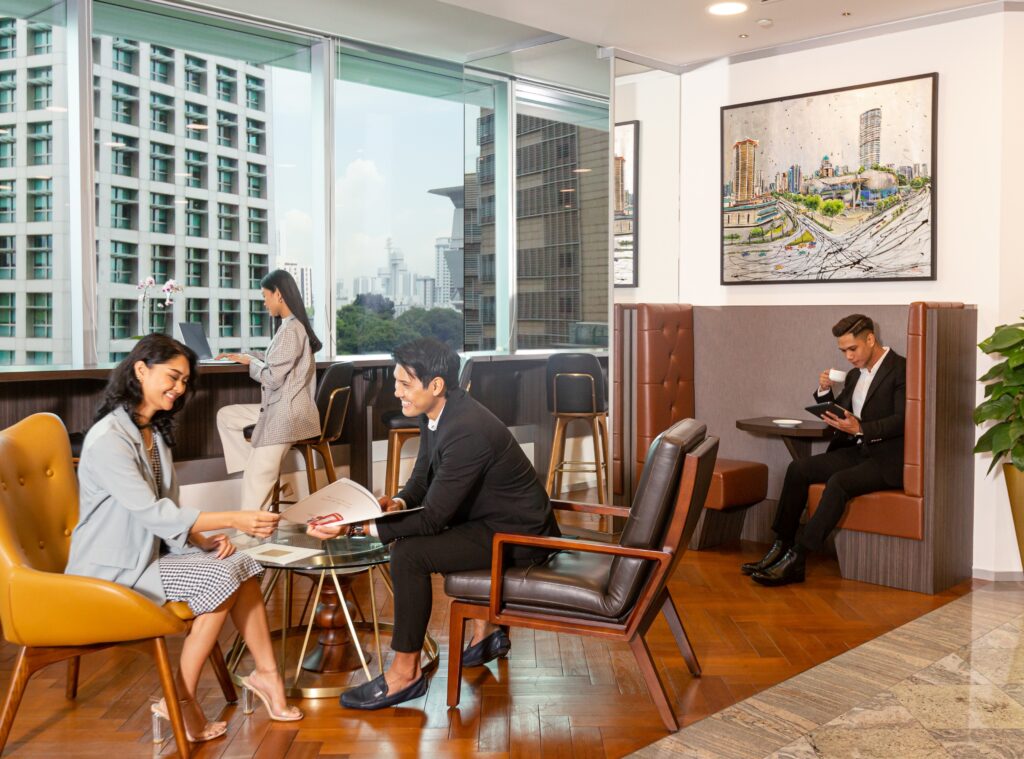Not all coworking spaces are built equally. Some offer open desks on a casual basis, others provide private offices with full-time access. What separates one from another is the coworking model, the way the space is structured, priced, and used.
These models aren’t just about layout. They shape how teams work, how freelancers interact, and how businesses grow. Whether it’s a hot desk for a day or a hybrid setup for a distributed team, selecting the ideal type of coworking model can enhance productivity, lower costs, and provide the kind of flexibility that traditional offices often struggle to match.
In cities like New York, London, and Riyadh, coworking models continue to evolve. This guide breaks down the different types of coworking spaces, enabling you to select one that suits your work style.
What is a Coworking Model?
A coworking model is the framework that defines how a shared workspace operates. It covers how desks are used, how much access you get, the level of privacy, and what’s included in the setup. Some models let people drop in and work at any available desk. Others provide assigned spots or enclosed offices.
Coworking spaces are beyond trends and are highly functional. Models affect how you interact with the space and the people in it. For example, someone running a consultancy might need a private room, while a freelance designer may only need a desk twice a week.
Knowing the model before you sign up means fewer surprises. Ironing this out early by outlining what coworking spaces offer will help you understand what you need daily, occasionally, or somewhere in between.
Quick summary:
-
Coworking models define how space, access, and usage are structured
-
Layout, seating type, and commitment terms vary between models
-
Choosing the right model depends on how you work and what you need
-
Helps avoid wasted time, mismatched pricing, or workspace friction – pick the right coworking space membership
Hot Desk/ Open-Plan
A hot desk is a flexible seat in a shared workspace. It isn’t assigned or reserved. This first-come, first-served model involves arriving, finding an available spot, and settling in for the day. This model is used by coworking operators globally, from large city hubs to suburban pop-ups.
Hot-desk zones are typically open-plan and include Wi-Fi, power, shared desks, and access to communal facilities like kitchens and lounges. Many spaces also offer quiet areas, phone booths, or casual meeting zones for hot-desk users, depending on availability.
Hot-desking is considered the most cost-efficient way to access a coworking space. It works well for people who don’t need a fixed location every day, or who work irregular hours. Freelancers, remote workers, consultants, and digital nomads often use hot desks to break up isolation or get out of the house for focused work.
It’s also useful for testing the coworking environment before committing to a full membership. For startups or solo founders, hot desks offer access to a professional setting without the cost or formality of private space.
This flexible model continues to grow as work becomes more location-independent. As usual, most hot desking locations include access to conference rooms, meeting rooms and private workspaces for an additional cost.
TLDR:
-
Hot desks are shared, unassigned workstations in open-plan coworking areas
-
You arrive, choose a seat, and work during available hours
-
Ideal for freelancers, remote workers, and part-time users
-
Common entry point due to low cost and flexible access
Dedicated Desks (Fixed Seating)
Some people don’t want to pack up their laptop and charger every time they leave. That’s where dedicated desks come in. These are fixed workstations assigned to you, so you can return to the same spot every day. It’s a familiar desk in a shared environment, with your gear right where you left it.
Dedicated desk plans often include storage, like lockable drawers or a cabinet, and some allow light personalisation. They’re usually located in semi-quiet zones, where members value routine and consistency more than casual drop-ins.
This model tends to attract people with structured work schedules. Think solo operators, startup founders, or consultants running multiple projects who need a predictable space. If you hold regular calls or meet clients occasionally, a set desk makes things easier.
Costs vary across countries and cities. In most urban coworking spaces, a dedicated desk costs between $300 and $600 per month, depending on amenities and location.
It’s a step up in focus, personal space, and professional environment without moving into whole office territory. Again, they should be accompanied by your standard suite of services that most coworking spaces offer.
TLDR:
-
Reserved desks that stay assigned to one person
-
Ideal for members who need routine, equipment setup, or privacy
-
Offers more permanence than hot-desking without the cost of a private office
-
Frequently used by consultants, startup teams, and full-time freelancers
Private Offices (Enclosed Suites)
Not to be confused with a traditional office space, but private offices inside shared workspaces are also considered a type of coworking space. Sometimes you need more than a desk. You need walls, a door, and space for a private team.
This flexible space offers a fully enclosed room, often lockable, usually furnished, and available for lease every month. You still access shared amenities like lounges, reception, kitchens, and bookable meeting rooms, but the core space is yours. Small businesses looking to scale love these types of collaborative models.
Private offices are often used by startups, legal professionals, financial services teams, and remote offices for larger companies. These spaces make sense for teams who need to focus, meet with clients, or hold internal meetings without using shared areas.
Some providers allow you to customise the layout or add branding to the door. Others offer all-inclusive plans that cover internet, cleaning, mail handling, and receptionist services.
Sizes range from one-person rooms to suites that hold 10 or more.
Across major cities, private offices within coworking environments typically range from $1,200 to $2,500 per month, although premium spaces in global hubs may cost significantly more.
This model suits businesses that want privacy and presence, without the need to sign a long lease or manage fit-outs. Coworking space types are a broad category, so keep your mind open to the definition of a collaborative workspace.
TLDR:
-
Fully enclosed, lockable spaces within coworking locations
-
Used by small teams, founders, consultants, or remote corporate branches
-
Offers privacy, branding potential, and dedicated access
-
Monthly pricing varies widely depending on size and city
Hybrid / Flexible Plans
Coworking doesn’t need to be one thing or the other. Different types of coworking spaces across the globe now offer hybrid plans, giving blended access that combines hot desking with fixed desks or private rooms. All kinds of combinations are possible.
A hybrid plan might give a team a private office three days a week, with hot-desk access the rest of the time. It could also include meeting room credits, multi-location access, and digital workspace tools under one membership. The end game is seeking flexibility and eliminating overcommitment to space that is underutilised.
This model has become increasingly popular as hybrid work has settled in. Teams work from home some days, meet in person on others, and need a workspace that matches that rhythm. For growing companies, hybrid plans also reduce real estate costs while giving staff the option to collaborate face-to-face.
Since 2022, the Asia-Pacific region has seen a sharp increase in hybrid-style coworking adoption, especially in metro areas where startups and satellite teams are scaling fast.
TLDR:
-
Combines elements of hot desks, dedicated desks, and private offices
-
Designed for flexibility across access levels and team structures
-
Popular with hybrid teams and companies testing remote operations
-
Gained traction in the Asia-Pacific region post-2022
Niche and Themed Coworking
Some coworking space aren’t trying to appeal to everyone, and they don’t have to. Different types of coworking spaces are suitable based on your interests and needs. Niche and themed models are designed with specific users in mind, often shaped by industry, purpose, or shared identity.
You’ll find creative collectives with podcast studios and art-friendly layouts, legal hubs that bake in confidentiality and client rooms, and tech clusters built for developers who want high-speed internet and somewhere to whiteboard. These spaces aren’t just places to work. They’re places to belong.
Others are built around a thriving community. Women-only spaces, neurodiverse-friendly layouts, or coworking hubs for religious or cultural groups. It’s less about how many desks, and more about how the people using them connect.
They are specific and purpose-built, which often leads to better networking opportunities!
TLDR:
-
Built around industries, identities, or shared interests
-
Examples include women-focused spaces, legal-specific hubs, and digital nomad enclaves
-
Often prioritise community fit and tailored amenities over general access
-
Designed to attract a specific kind of member, not everyone
Corporate / Enterprise Coworking
When coworking first arrived, it was catered for startups and small businesses, but the landscape is no longer the same. In recent years, major corporations have adopted shared space models, some as a permanent solution, others as part of a hybrid strategy.
Enterprise coworking refers to space configured for teams of 20, 50, or even hundreds. These setups look more like managed offices but are delivered with the agility of coworking. Companies bring in staff, keep control over layout and operations, and benefit from shared infrastructure they don’t have to manage themselves.
Security and tech are major factors. These spaces often include private server rooms, access control, and VPN-ready networks, especially when dealing with finance, legal, or healthcare teams.
Big names have taken part. Microsoft and Salesforce have partnered with coworking providers to support remote teams, pilot innovation labs, or open local hubs without committing to long-term commercial leases.
For enterprises, coworking offers speed. It’s faster to open, easier to manage, and can scale with less risk. For the coworking industry, enterprise demand has become a key growth engine.
TLDR:
-
Designed for larger teams, remote branches, or distributed workforce hubs
-
Prioritises IT security, access control, and brand customisation
-
Adopted by companies like Microsoft and Salesforce
-
Offers scalability without long-term leasing
Virtual Coworking
Beyond the dedicated office space we’re used to, remote work can also be arranged into a type of coworking space arrangement. The connection extends more than a group chat or a video call; rather, virtual coworking spaces are carefully planned live sessions with screen-sharing workflows to help accountability.
Members might log on to work silently on camera, join focused work sprints, or chat during scheduled breaks. When we look at coworking space examples, this model is an outlier, which is why it’s dominated by solopreneurs and digital nomads wanting routing without geographic limitations.
Tools like Slack, Zoom, Discord, and Notion are a favourite.
It’s certainly not a replacement for the standard shared office space, but for those working fully remotely, it’s a low-cost method for staying connected and motivated.
Premium and Wellness-Focused Coworking Spaces
Some coworking spaces focus on offering more leisurely services to individuals paying higher membership fees. They are designed to feel more like boutique hotels or private clubs. Premium coworking models lean into experience; it’s about selling a “feeling”.
Design is a major part of the offering. You’ll find natural lighting, ergonomic furniture, acoustic controls, and curated decor. Some premium spaces allow light customisation or include private balconies, art installations, or VIP zones.
Wellness is often woven into the membership. It’s common to see on-site fitness facilities, yoga rooms, nap pods, or access to mental health support. For members working long hours or managing multiple roles, these perks are part of the value.
This model tends to attract people who aren’t just looking for a desk. Remote executives, independent consultants, and creative leads often opt for premium spaces because the environment reflects their work style and the clients they serve.
It’s a smaller segment of the market, but a growing one, especially in cities where lifestyle and brand presence matter.
Selecting The Right Coworking Model
Choosing a coworking model depends less on the features and more on how you work day to day. A startup founder working full-time with a small team needs something different from a freelancer who comes in twice a week.
Here’s a quick comparison to help guide that decision:
|
Model |
Privacy |
Flexibility |
Monthly Cost (Typical Range) |
Best For |
|---|---|---|---|---|
|
Hot Desk |
Low |
High |
$100–$300 |
Freelancers, casual users |
|
Dedicated Desk |
Medium |
Moderate |
$300–$600 |
Solo professionals, consultants |
|
Private Office |
High |
Lower |
$1,200–$2,500+ |
Startups, remote teams, small agencies |
|
Hybrid Access |
Variable |
High |
Varies (usually bundled) |
Hybrid teams, project-based work |
|
Premium/Wellness |
Medium |
Moderate |
$500–$1,500+ |
Executives, brand-conscious members |
Pricing can shift based on region, space size, and included services, but this breakdown gives you a starting point.
If you’re comparing multiple spaces, visiting each one or using a coworking aggregator app can help test fit before you commit.
Your Final Checklist: Deciding Between Various Types of Coworking
This process is more than navigating desk sizes and prices. Whether you need quiet, consistency, or flexibility to move around, each model has its place. What matters is finding one that supports your habits, your team, and your goals.
Here are a few things to ask before signing up:
-
How often will I use the space each week?
-
Do I need a fixed desk or can I work from anywhere?
-
Will I be meeting clients or taking calls?
-
What hours will I use it, and are those hours included?
-
Can I grow into a different plan later if my needs change?
-
What’s included in the cost (internet, meeting rooms, printing)?
-
Do I feel comfortable in the space when I walk in?
What are some common coworking space names?
Coworking space names often reflect the vibe or community they serve. You’ll see names inspired by creativity (like “The Wing” or “Betahaus”), location (“Spaces London Bridge”), or professionalism (“Servcorp”). Operators often brand around flexibility or focus to attract the right members.
What is considered a small coworking space?
A small coworking space usually hosts fewer than 20 members at a time. These spaces often operate in a single-room layout, with limited hot desks, a couple of private offices, and shared amenities. They’re common in suburban areas or niche setups like podcast studios or creative hubs.
What are the types of coworking space in London?
London offers a wide range of coworking models, from flexible hot desk setups in Shoreditch to premium private suites in Mayfair. Types of coworking space in London also include hybrid access models, industry-specific hubs, and virtual coworking memberships for remote teams based across the UK.





